Woodard & Curran has long made improvements in our business operations to reduce our environmental impacts, as well as improve efficiency and processes. In 2017, we developed a formal reporting framework, which has prompted us to make a concerted effort to analyze data to better understand our impact and undertake initiatives to reduce these impacts. Our use of resources as a consulting and operations firm falls under the general categories of travel, office space, and purchasing.
The pandemic shifted the way we conduct business, which we expect to factor in some adjusted processes as we slowly return to the offices. However, we are excited to reflect on the past few years of tracking the impact of our business operations, share the actions we took to address our impact, and future plans.
Offsetting our business travel impact
Business travel and employee commuting has always been our biggest source of greenhouse gas (GHG) emissions from a business operations perspective. In 2019, employee commuting, fleet vehicles, other vehicle use, and air travel accounted for 86 percent of our analyzed GHG emissions. In 2020, this figure dropped to 76 percent due to our shift to remote work and restricted travel. Between 2016 and 2019, there was an increase across all sources, which we largely attribute to our growing Operations & Management (O&M) business, more cross-country travel to support our national footprint, and better reporting of rental car use, personal vehicle fuel purchases, and employee commuting. Armed with this data, last year we purchased 1,343 metric tons (MT) of carbon offsets from two landfill waste-to-energy sites in the Northeast through CarbonFund.org. This first-time purchasing company-wide carbon offsets accounted for just under half of our 2019 air travel emissions.
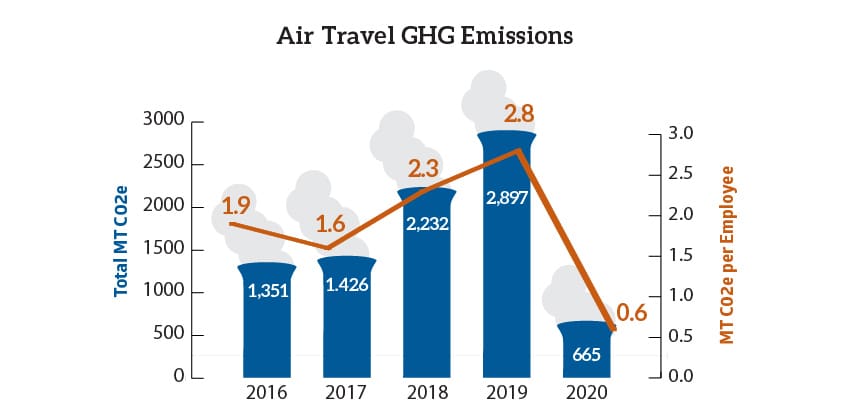
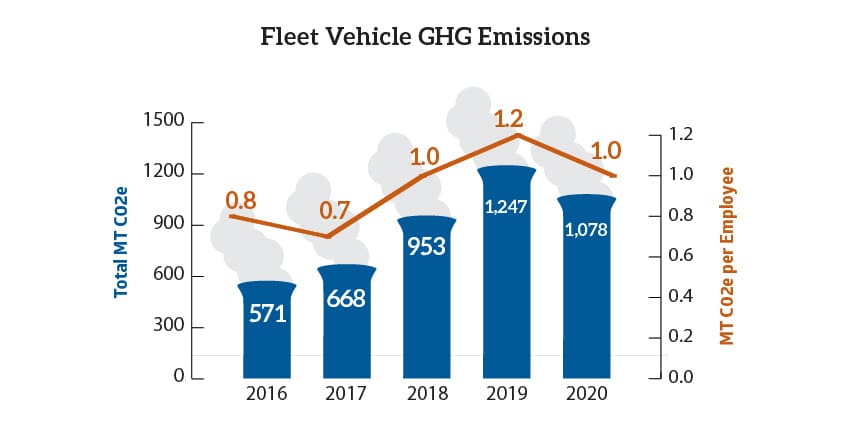
In 2020, our total emissions per employee was 5.8 MT, which is well below our 2025 goal to “reduce our emissions per employee by 20 percent to 6.7 MT.” However, data from 2019 paints a more realistic picture indicative of the increased impact caused by travel. We expect to see many changes in our business operations the remainder of this year and going forward. As such, we are making plans for a more efficient use of resources to lessen our impact on the environment. For example, we are investing in a more comprehensive fleet vehicle management system that will allow us to make better decisions regarding our use and need for these vehicles. We are also determining how we will invest in more carbon offsets, reflective of our 2020 emissions, as part of our commitment to mitigate our impact on climate change.
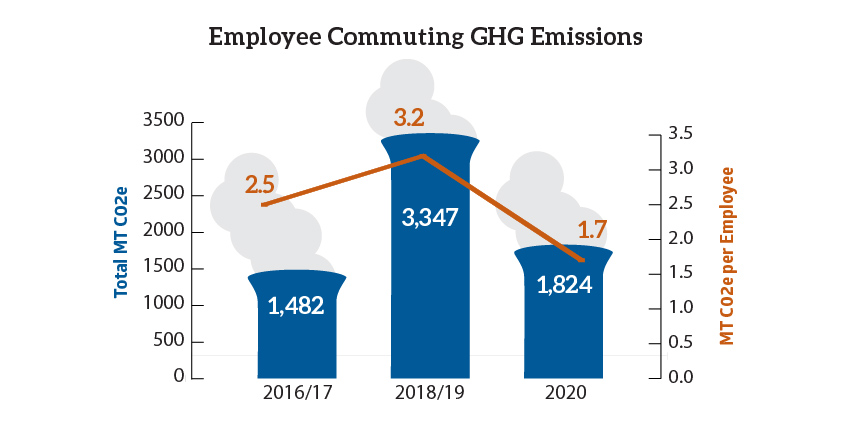
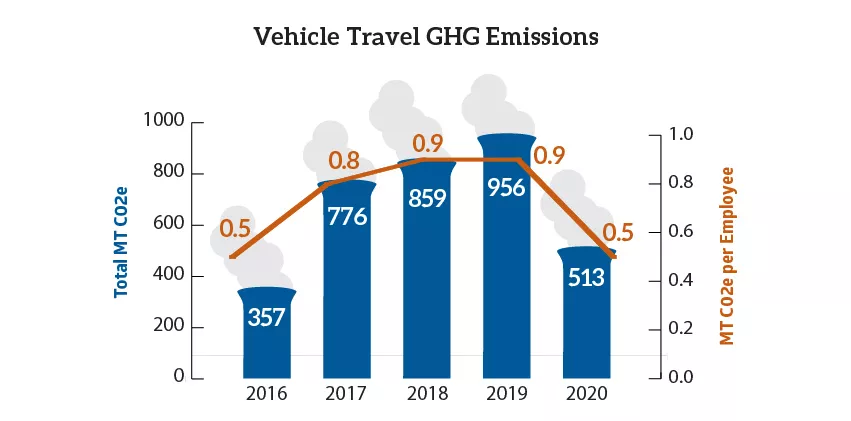
Engaged and sustainable office communities
Our offices exist to provide healthy, productive workspaces for our employees to thrive. However, we are aware of our footprint in occupying these spaces and aim to decrease square footage when possible, as well as adjust to using our space more efficiently. We piloted our Office Sustainability Program in 2019 as a framework of actions our offices can undertake to improve upon existing infrastructure in ways that make the space healthier and sustainable. The program provides employees with a checklist of actionable items divided into ten categories: administrative/leadership; purchasing; community engagement; committed colleagues; diversity, equity, and inclusion; waste; water; emissions and energy; health and wellbeing; and innovation. We received significant employee engagement since launching this program and office colleagues continue to share unique actions that spur positive change.
Our electricity usage per employee decreased by 38 percent from 2016 to 2019 and 74 percent from 2016 to 2020. Heating saw a 2 percent increase in 2020 compared to 2016. We will continue to address this data by moving into more efficient spaces, shifting to a cloud-based system, and conducting annual office condition reports to gauge employee comfort. In part, we are also discussing the future of office spaces, what that will look like, and how we can adjust our goal for green offices. In 2019, 32 percent of our employees sat in LEED or Energy Star-certified space. While we cannot always control the green certified status of the offices we occupy, we continue to set goals based on our own criteria to foster sustainable offices.
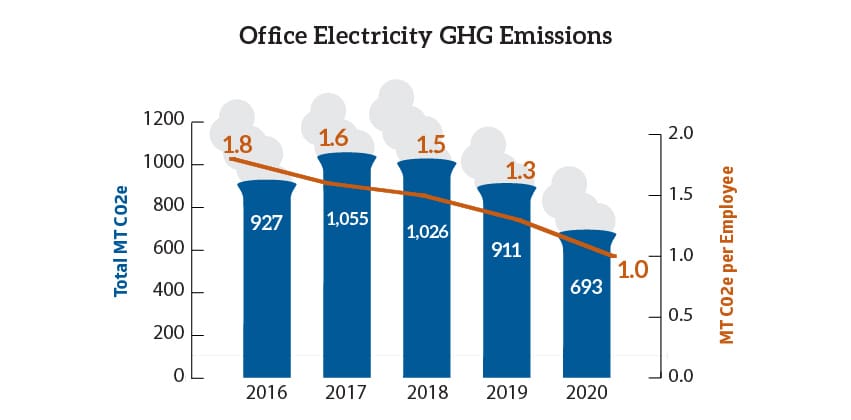
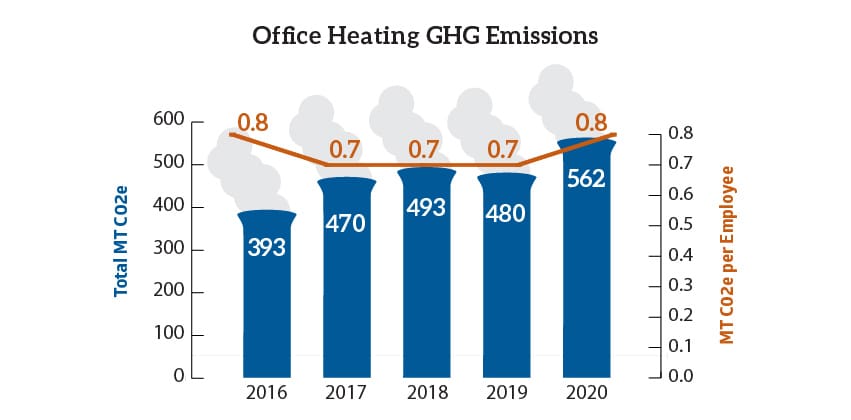
Small changes to paper use equals big impacts
After evaluating paper purchasing practices in 2016, we moved to increase our standard of recycled paper content. Since then, our recycled paper content use jumped from 5 to 27 percent, and we also saw big changes in paper use.
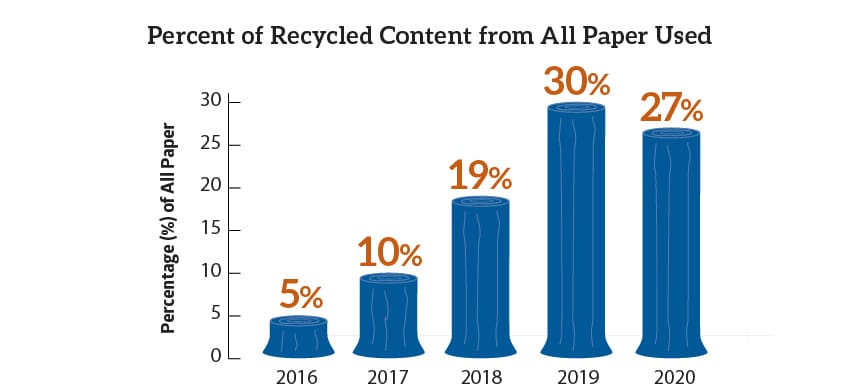
The average amount of paper used per office employee dropped from 92 to 56 pounds between 2016 and 2019. In 2020, that dropped to 24 pounds per office employee, most likely due to our shift to work from home starting in March through year end. Even still, this decrease in paper usage has surpassed our 2025 goal and is consistent due to implementation of paperless processes and easier access to online tools.
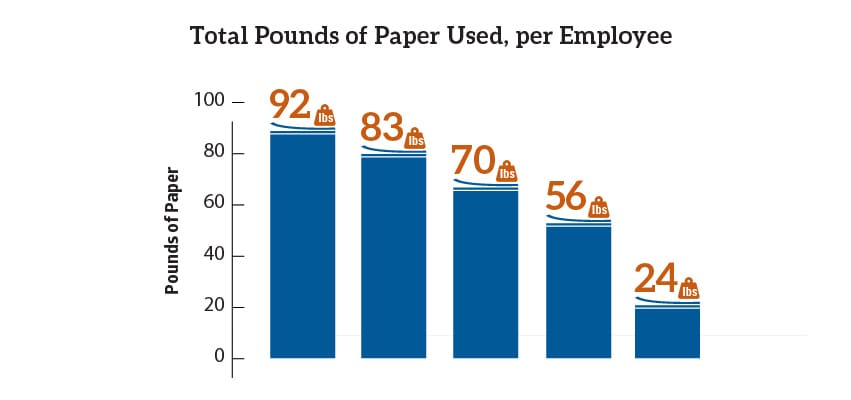
In terms of “green spending,” we have ranged from 26 to 32 percent from 2016 to 2019. Again, 2020 saw a dip to 19 percent, largely attributed to a different set of needs for office supplies based on our remote work status. As such, we are revisiting guidance for planned purchases for 2021 and beyond.
Green Team champions serve as employee advocates
Our Green Team helps keep us accountable for our sustainability goals. With more than 50 employees across our offices, Green Team Champions are dedicated to making our business operations more environmentally sustainable within each office setting. These employee volunteers have helped develop an inventory of our standards on e-waste and battery disposal, drafted sustainable business travel guidelines, communicated numerous campaigns to their colleagues and engaged in waste stream data collection efforts.1
These employees also spearhead our annual Earth Week Challenge, encouraging colleagues to team up and compete on sustainable actions. Over the past few years, the Green Team has also spearheaded new campaigns relevant to current issues, such as energy efficiency, paper usage, and social and environmental justice.
1 Our 2020 plan included a revised waste stream assessment. Since we were not able to perform this analysis, we removed this metric from our current reporting efforts until we revisit the applicability of gathering this data.
